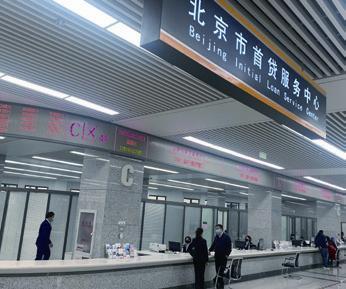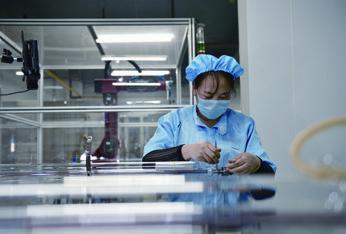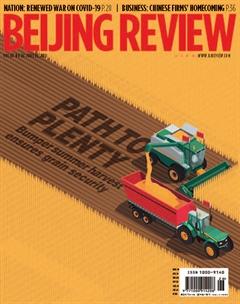Capital Measure
By Zhang Shasha
Lai Huigang, founder of Xiaoerjie, a fresh food store chain, thanks a recent government policy for his organizations expansion in May despite the effects of the novel coronavirus. Xiaoerjie opened three new stores in Jiangmen, a city in Guangdong Province, south China, after receiving a shot in the arm from a state guarantee finance program.
Like other small and medium-sized enterprises (SMEs), Xiaoerjie too had been rattled by the epidemic. Its sales in the city had dropped by 50 percent in the fi rst quarter and some stores had run out of capital. Banks became even more cautious of lending money to SMEs like Xiaoerjie, given their low ability to withstand risk.
However, the Human Resources and Social Security Bureau of Jiangmen launched a program with 10 banks to bail out SMEs. The government became the guarantor for loans and also subsidized the interest on these loans. It set up a 100-million-yuan ($14.1-million) fund to provide 70 percent of the guarantee money.
“The government shares the risk of financial institutions, which makes them more enthusiastic to lend to SMEs, providing capital for companies like us to expand business and upgrade operation,” Lai said.“In the past, we needed to have fixed assets as collaterals to get a loan. This time the government stepped in, playing a big role.”
Xiaoerjie obtained 3 million yuan($423,000) through the program. By midMay, the program had disbursed loans amounting to 15.7 million yuan ($2.21 million).
Government guarantees have played a crucial role in solving SMEs fi nancing problems and reducing their financing costs. And there are more new measures to help them out. On May 27, the Financial Stability and Development Committee under the State Council, Chinas cabinet, announced 11 measures to buoy the real economy, with the majority of them focusing on financial services for SMEs.
Keeping a commitment
This echoes the spirit of the Report on the Work of the Government tabled by Premier Li Keqiang at the annual session of the national legislature this year, in which he said, “To support market entities, we must ensure that micro and SMEs (MSMEs) have signifi cantly better access to loans and that overall financing costs drop markedly.”They play an integral role in achieving “security in the six areas” and “stability on the six fronts,” a major subject at this years legislative session.The six areas are job security, basic living needs, operations of market entities, food and energy security, stable industrial and supply chains, and the normal functioning of primary-level governments. The six fronts are employment, the financial sector, foreign trade, foreign investment, domestic investment, and peoples expectations.
Due to the uncertainties brought on by the novel coronavirus disease (COVID-19) pandemic and the global economic and trade environment, this year the government did not set a specific target for economic growth. So the two “sixes” have become an important standard to measure the economic performance.
As a crucial content in the two “sixes,”ensuring employment and peoples wellbeing are of great significance. “We must instill confi dence in over 100 million market entities; and we must do our utmost to help enterprises, particularly MSMEs and self-employed individuals, get through this challenging time,” the work report said, adding that the government will increase financial support to keep business operations stable.
It also said the policy allowing MSMEs to postpone principal and interest repayments on loans will be further extended till the end of March next year. Payments on all inclusive loans of micro and small businesses eligible for this policy will also be deferred, and other businesses facing fi -nancial diffi culties can discuss similar terms with their creditors.
Banks will be encouraged to substantially increase credit loans, fi rst-time loans, and loan renewals without repayment of principal for micro and small businesses. The scope of the government financing guarantee will be expanded and guarantee fees will be reduced significantly. Large commercial banks should increase inclusive lending to micro and small businesses by more than 40 percent.
The 11 new measures taken at this critical time will help implement the steps proposed by the report by providing highquality financial services, Xu Hongcai, Deputy Director of the Economic Policy Commission, China Association of Policy Science, told Beijing Review. They also set the tone for future fi nancial market reform and deliver a clear signal of continuing the fi nancial opening up, he added.
Sharing risks
According to the May 27 announcement, an improved incentive and restraint mechanism will be introduced to encourage commercial banks to provide fi nancial services to micro and small enterprises more effi ciently.Banks will be evaluated on their credit allocation, implementation of regulatory policies and product and service innovation. They are encouraged to provide differential pricings when lending to those enterprises.
“It is imperative to establish and improve an incentive and restraint mechanism,” Xu said. He said fi nancial institutions tend to avoid risks and in the face of a downward pressure, like now, are prone to tighten loans. Thus, a mechanism combining incentive and restraint is needed. While encouraging financial institutions to lend to SMEs, it is also important to control risks.
“The measures highlight each fi nancing link of SMEs and make cutting financing costs and improving fi nancing effi ciency a standard,” Wen Bin, chief economist with China Minsheng Bank, told Economic Daily.“While taking into account the individual differences of commercial banks and real practices of SMEs fi nancial services, it sets differentiated evaluation indicators and demands for commercial banks to fulfi ll their duties. It also allows for differentiated pricing regarding SMEs to strengthen how the evaluation result is used.”
Wen also said the evaluations should be more specifi c and differentiated so that banks can provide differentiated services and tide SMEs over diffi culties.
In addition, further reform of small and medium-sized banks will be carried out, such as accelerating their capital replenishment, raising funds through multiple channels and combining capital replenishment with corporate governance optimization.
In China, there are more than 4,000 small and medium-sized banks, whose asset scale accounts for over 50 percent of all commercial banks. They have played an irreplaceable role in backing local economic development, serving SMEs and promoting agricultural development. However, insuffi -cient capital has become a prominent issue for them.
By the end of the first quarter, the capital adequacy ratio of Chinas commercial bank was 14.5 percent, whereas for urban commercial banks and rural commercial banks it was only 12.7 percent and 12.8 percent respectively, according to China Banking and Insurance Regulatory Commission.
The asset expansion of small and medium-sized banks, especially credit supply, is restricted by limited capital, which also leads to higher operational risks.
The new measures mean capital replenishment will be gradually implemented and in the future, the source of capital for small and medium-sized banks will com- prise retained earnings, capital gained by issuing common and preferred stocks, and perpetual and secondary capital bonds. It will also include capital injected by local finance and state-owned companies, and capital replenished by private companies and foreign-funded institutions.
“The capital replenishment will ease small and medium-sized banks lack of capital and the impact caused by the pandemic on their asset quality, enhancing their risk-bearing capacity to better serve SMEs,” Lu Zhengwei, chief economist with the Industrial Bank, told Economic Daily.
Moreover, the new measures will encourage state guarantee institutions at all levels to support small businesses and farmers by sharing risks and helping them overcome diffi culties and resume work.
Xu said the risks should be shared jointly by guarantee institutions, enterprises, banks and governments. “Therefore, it is important to have guidelines for evaluating the performance of state guarantee and reguarantee institutions,” he said. “This will encourage these institutions to control their own risks and provide financial services without fear.”
According to Wen, the measures will raise the efficiency of the capital market, better protect the rights and interests of investors and maintain financial stability. This, in turn, will better support social and economic recovery and development.

